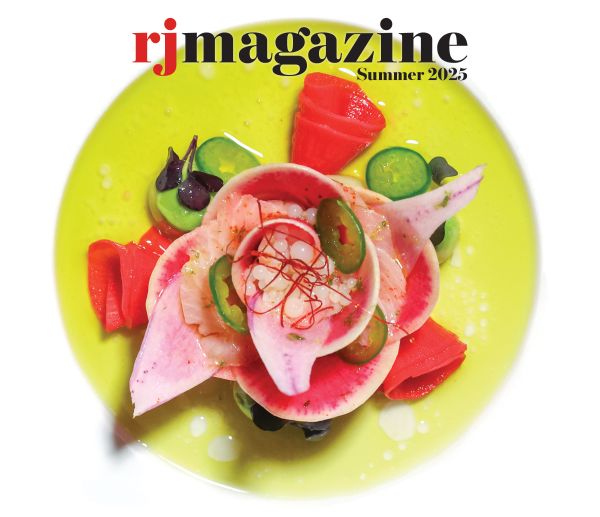Mediterranean diet may help you drop weight, improve health in 2012
When it comes to New Year's resolutions -- especially as they apply to eating right -- cardiologist Frederick Schaller has heard the same thing, over and over again.
"People think that on the first of January they're never going to eat their favorite food again, and that's never going to work," said Schaller, vice dean of the college of osteopathic medicine at Touro University.
"Set a goal that's reasonable, or else you're setting yourself up for failure."
One concept that's making the rounds again is the Mediterranean diet, which is not so much a diet, per se, but a way of life, a way of eating. Proponents maintain that by eating more like the way our brothers and sisters in the Mediterranean region do, we can become healthier and maybe even trimmer in the process.
"Absolutely, I think it's a good idea," Schaller said. That's because, he said, it meets the criteria for a dietary reality check: It's easy to do, not expensive and is enjoyable, so you're more likely to stay with it.
"Fad diets are worthless," he said. "You lose weight, drop the new habits and go back to your old weight."
Mary Wilson, a registered dietitian and extension nutrition specialist for the University of Nevada Cooperative Extension, said the crux of the Mediterranean diet is that it's plant-based rather than meat-based. She noted that the U.S. Department of Agriculture, through its MyPlate initiative (www.choosemyplate.gov), recommends that three-quarters of the plate be taken up by plants -- fruits, vegetables and grains.
"It continually emphasizes the importance of fruits and vegetables and whole grains," Wilson said. "We've been trying to impress that on the American public for so long."
Schaller said the Mediterranean diet works because it's healthful, tasty and incorporates broad ranges of foods.
"Even if you don't like some things, there very likely are some things in that diet that you do enjoy," he said. "It's not a huge change in eating habits. It can result in a significant reduction in cardiovascular risk."
Weight loss isn't a main focus of the diet, Schaller said, but can come about as a side effect because of the benefits of more healthful eating.
Wilson said the Mediterranean diet shares many similarities with another diet that research has shown to be healthy, that of the Japanese.
"The center of them is they're plant-based," she said. "They eat fruits and nuts and seeds for snacks. There's minimal processing. They eat fish more often than we do. When they eat poultry, it's skinless. They don't eat a lot of eggs. They limit red meat to a few times a month, and it's usually small portions."
Fats are likewise plant-based -- think olive and canola oils -- which means they're lower in saturated fats and higher in monounsaturated and unsaturated fats.
"They do yogurt, nonfat and low-fat versions," she added. "Milk's not a mainstay, but yogurt is."
The most-commonly consumed dairy products in America are in the 2 percent-fat range, Wilson said, although the health-education and medical communities continue to extol the benefits of shifting to 1 percent or low-fat.
"If we could get Americans to do that, it would be very helpful," she said.
Wilson and Schaller said there are several ways to move toward modeling your diet after the Mediterranean ideal.
"First," Schaller said, "recognize that diets should not be something that you see as a negative. If you look at it as food options, there are many, many different things I can choose from, rather than 'I can't have that, I can't have this.' "
He suggested Googling "Mediterranean diet" to get the basic concepts.
"It will show you the core items that are there," he said, such as a focus on fruits and vegetables, a wide variety of nuts and starches, less red meat, more fish and chicken.
And the main thing, he added, is that such a diet shifts away from saturated fats, such as butter and cheese.
"Olive oil is a healthy oil," Schaller noted. "You can cook things with it, use it in salad dressings, even substitute that oil for some of the things that are made with butter. You're not going to make Grandma's poundcake on a Mediterranean diet," he said, but you can alter the preparation of many other dishes.
Fill up on fruits, vegetables and grains, Wilson recommended.
"I'm always thinking about what vegetables I'm going to serve with a meal, what grain I'm going to serve with a meal, and then I try to keep the portion sizes of proteins smaller."
Maybe start making one meal a week meatless, she added, noting that Meatless Mondays is a theme that's gradually spreading across the country.
"That's a good start, to try to get people to do that," Wilson said. "People think once a week can't make a difference, but it can. It would be a step in the right direction."
And, Schaller said, there may be a side benefit.
"When you start getting rid of the saturated fats, that's where the calories come down," he said. "That's where the weight loss comes."
RED-WINE RISOTTO
4½ cups reduced-sodium beef broth
2 tablespoons extra-virgin olive oil
1 medium onion, finely chopped
2 cloves garlic, minced
1½ cups arborio, carnaroli or other Italian "risotto" rice
¼ teaspoon salt
1¾ cups dry red wine, such as barbera, barbaresco or pinot noir
2 teaspoons tomato paste
1 cup finely shredded Parmigiano-Reggiano cheese, divided
Freshly ground pepper, to taste
Place broth in a medium saucepan; bring to a simmer over medium-high heat. Reduce the heat so the broth remains steaming, but is not simmering.
Heat oil in a Dutch oven over medium-low heat. Add onion and cook, stirring occasionally, for 5 minutes. Add garlic and cook, stirring, until the onion is very soft and translucent, about 2 minutes. Add rice and salt and stir to coat.
Stir ½ cup of the hot broth and a generous splash of wine into the rice; reduce heat to a gentle simmer and cook, stirring constantly, until the liquid has been absorbed. Add more broth, ½ cup at a time along with some wine, stirring after each addition, until most of the liquid has been absorbed. After about 10 minutes, stir in tomato paste.
Continue to cook, adding broth and wine and stirring after each addition until most of the liquid is absorbed; the risotto is done when you've used all the broth and wine and the rice is creamy and just tender, 20 to 30 minutes more.
Remove the risotto from the heat; stir in ¾ cup cheese and pepper. Serve sprinkled with the remaining ¼ cup cheese.
Serves 8 as a side dish.
-- Recipe from Eating Well
BALSAMIC ROASTED VEGETABLES
2 tablespoons balsamic vinegar
1 teaspoon Dijon mustard
½ cup extra-virgin olive oil
3 garlic cloves, pressed
2 teaspoons finely chopped fresh thyme
1 teaspoon finely chopped fresh basil
2 large red onions, halved, thinly sliced
1 yellow bell pepper, cut into ½-inch-wide strips
1 red bell pepper, cut into ½-inch-wide strips
1 orange bell pepper, cut into ½-inch-wide strips
One 1-pound eggplant, quartered lengthwise, cut crosswise into ½-inch slices
½ pound yellow squash (about 2 medium), cut into 1/3-inch-thick rounds
½ pound zucchini (about 2 medium), cut into 1/3-inch-thick rounds
Coarse kosher salt and pepper
Whisk vinegar and mustard in medium bowl. Gradually whisk in oil. Stir in garlic, thyme and basil. Season to taste with salt and pepper. (Dressing can be made one day ahead; cover and chill.)
Preheat oven to 450 degrees. Toss onions and next six ingredients in large bowl; sprinkle with coarse salt and pepper. Add dressing; toss to coat. Divide between two large rimmed baking sheets. Roast until vegetables are tender and slightly brown around edges, about 35 minutes.
Serves 6.
-- Recipe from Bon Appetit
PITA SALAD WITH CUCUMBER, FENNEL AND CHICKEN
2 6-inch pitas
2 cups thinly sliced fennel bulb
1 cup shredded skinless, boneless rotisserie chicken breast
½ cup chopped fresh flat-leaf parsley
¼ cup vertically sliced red onion
½ English cucumber, halved lengthwise and thinly sliced
½ teaspoon salt, divided
¼ teaspoon black pepper, divided
¼ cup fresh lemon juice
1 tablespoon white wine vinegar
½ teaspoon chopped fresh oregano
3 tablespoons extra-virgin olive oil
Preheat oven to 350 degrees.
Arrange pitas on a baking sheet. Bake at 350 degrees for 12 minutes or until toasted; cool 1 minute. Tear into bite-sized pieces.
Combine pita pieces, fennel and next four ingredients (through cucumber). Sprinkle with ¼ teaspoon salt and 1/8 teaspoon pepper.
Combine juice, vinegar, oregano, remaining ¼ teaspoon salt and remaining 1/8 teaspoon pepper. Gradually add oil, stirring with a whisk. Drizzle dressing over pita mixture; toss to coat. Serve immediately.
Serves 4.
-- Recipe from Cooking Light
CHICKEN & FARFALLE WITH CREAMY WALNUT SAUCE
1/3 cup walnuts
1 small clove garlic, peeled
¼ teaspoon salt
¼ teaspoon freshly ground pepper
Pinch of cayenne pepper
¼ cup reduced-sodium chicken broth
2 tablespoons finely chopped fresh parsley
½ teaspoon lemon juice
1 teaspoon walnut oil, or extra-virgin olive oil
8 ounces boneless, skinless chicken breast, trimmed of fat, cut into ½-inch pieces
4 ounces whole-wheat farfalle pasta
1 cup small broccoli florets
½ red bell pepper, seeded and cut into thin strips
Put a large saucepan of water on to boil. Combine walnuts, garlic, salt, pepper and cayenne in a blender; pulse until finely chopped. Blend in broth, parsley and lemon juice until smooth and creamy.
Heat oil in a medium nonstick skillet over medium-high heat. Add chicken and cook, stirring often, until it is no longer pink in the middle, 3 to 5 minutes.
Cook pasta for 5 minutes. Add broccoli and bell pepper, cook, stirring occasionally, until the pasta and vegetables are just tender, about 4 minutes more. Drain, return to the pot. Add the walnut sauce and chicken; toss to coat.
Serves 2.
Recipe from Eating Well
Contact reporter Heidi Knapp Rinella at hrinella@ reviewjournal.com or 702-383-0474.


















